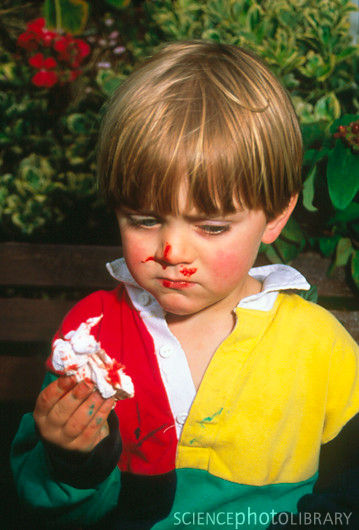Bloody Nosebleeds
My five year old son woke this morning with his nose bleeding, so I was inspired to bring you, the viewers this post on his request.
In the United States, one out of every seven people will develop a nosebleed at some time. Nosebleeds tend to occur during winter months in dry, and cold climates. They can occur at any age but are most common in children aged 2 to 10 years and adults aged 50 to 80 years.
Medical termed is (epistaxis). Nosebleeds are
more common in children than adult. This is due to the fact that children are prone to inserting their finger and other object into their nostrils. In addition, the tissue (mucous membrane lining) in child nose is much thinner than that of an adult, and therefore more susceptible to damage.
Causes: Any injury to the tissues inside the nose can cause a nosebleed. Injury such as, a blow to the nose, the intrusion of a foreign object, your fingers, a sudden change in atmospheric pressure, or simply blowing the nose too hard. Climate play a part as well, Winter often bring about nosebleeds because heated air tends to be dry. Excessive dryness can cause the nasal membranes to crack, corm crust and bleed.
In some cases, nosebleeds can be associated with underlying illness. such as, Arteriosclerosis, high blood pressure, malaria, scarlet fever, sinusitis, and typhoid fever, some of which can lead to some serious blood loss. There are two types of nosebleeds, depending on where in the nose the blood is coming from, Anterior and Posterior.
The overwhelming majority of nosebleeds are Anterior, in which bright red blood flows from the front part of the nose. If the person sits or stands the flow of blood comes out of one or both nostrils. If the person lies on his or her back, the blood may flow backward, into the throat. This can be frightening and it may look as if there is a lot of blood, but in reality it is not serious and very little blood is loss.
Posterior nosebleeds primarily affect elderly people and those with high blood pressure. Blood usually comes from the rear of the nose and run down the back of the mouth into the throat, no matter what position the person is in. The blood is usually dark red, although it can be bright red. If the bleeding is severe, blood can flow from the nose as well.
RECOMMENDATION: To stop anterior nosebleed, sit up in a chair and lean forward(do not tilt your head back).Do not put your head between your legs or lie flat on your back. Apply crushed ice or a cold washcloth to you nose, refrain from any physical activity. If you suspect posterior nosebleed, consult a doctor, this type requires the care of a physician.
For further info contact me (Empressicia) at thatplum@gmail.com
and write my name and/or in subject text, lifestyle or Empressicia
I’m not a medical doctor so any sharing of health educational information in this website should be taken as just that — the sharing of educational information. Please see the disclaimer link.

